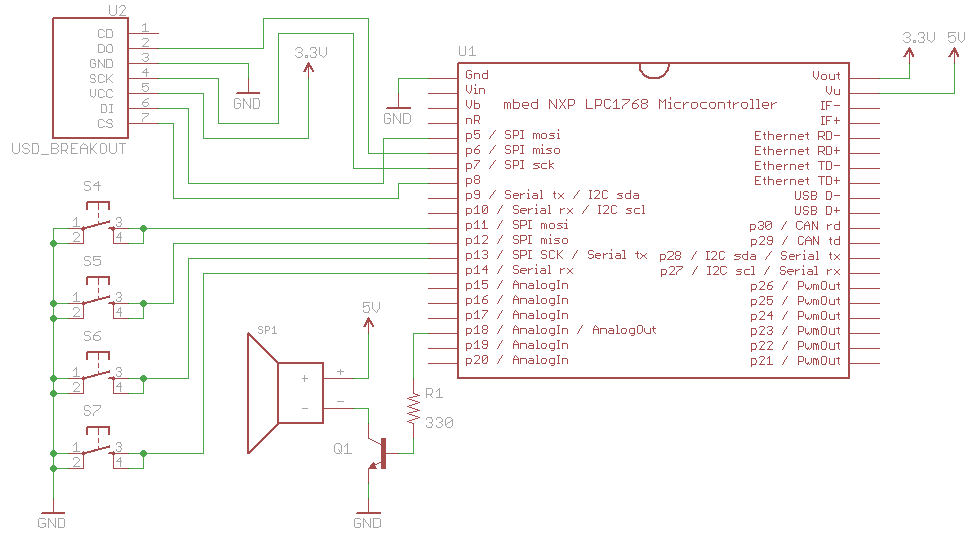

Let me describe brifly what happens in the main() function.
Mbed waveplayer code#
The code used in this project can be found below. The project is made using already available libraries from the big online mbed community – why reinvent the wheel? The project shown in the video above is a simple demonstration of using the Ethernet for wave-file downloading, saving the file to a USB Memory Stick, for later playback using the 10-bit DAC peripheral. So without an internet connection you won’t be able to make any applications for your mbed, without buying a compiler solution like KEIL uVision. The only minus about the online compiler is of course that it requires an internet connection. Therefor it is very easy to get started developing, as you don’t have to think about many lines of code for initializing the different peripherals. The API (functions) of the libraries are very similar to the one used in the Arduino world. The online compiler has a great number of libraries for all the peripherals. This means that your code is written online, saved online, compiled online and then downloaded to your computer as a binary file, ready to be copied to your mbed. Their online compiler is consists of their own online development IDE connected to different servers capable of compiling your code. When opening that you will be taken directly to the mbed homepage to register your new mbed and an account for their online compiler. When connecting the mbed to your computer you will find an HTML file on the flash drive.
Mbed waveplayer install#
To start creating applications for the mbed, you don’t even have to install anything on your computer. We are currently doing the final revisions of the board and hope to be able to sell this inexpensive board as a kit, in the beginning of 2012. This mbed Peripheral Board contains all the necessary connectors, so you will be able to use USB Host, USB Client, and Ethernet. To get you started even faster using one of the many peripherals on the mbed we decided to make a peripheral poard. All required external hardware for the different peripherals is already on the board (though some resistors and capacitors are still required).Īll this combined makes a great development tool for hobby or student use – well competitive with the well known Arduino. When you want to add USB Host or Client all you need is simply a USB connector. The board also contains the necessary external Ethernet PHY circuitry – so when you want to add Ethernet to your next application, all you need is simply a MAGJACK ethernet connector. The flash drive has a size around 2MB, and when the board is reset it automatically programs the most recent binary file into the LPC1768. By connecting the mbed to a computer, it will enumerate as a USB Flash Drive and to program the LPC1768 you simply drag the binary (.bin) file to the flash drive. The board also contains a USB port connected to the “mbed interface controllers” which takes care of the programming. The different peripherals is then brought out to these pins for an easy to use development solution.

The chip itself is placed on a “breadboardable” board with 2x 20-pins thruhole male headers. Besides of that it does also come with other standard microprocessor peripherals like USART, SPI, I2C, CAN, 12-bit ADC and a 10-bit DAC.
Mbed waveplayer mac#
It has built in 10/100 Ethernet MAC and a USB 2.0 compliant Host/Device/OTG port. This microprocessor has an ARM Cortex-M3 core running at 72MHz. To start with please take a look at the Video demonstration when I show the board itself and a breakout board we made, making it easy to get started using both USB and Ethernet.Īs said in the prelude the mbed contains an LPC1768 microprocessor from NXP. The board have many different features, including USB Host, USB Client, Ethernet, SPI, I2C, PWM and much more – everything controlled by the LPC1768 microprocessor running at 96MHz. The mbed is an easy to use microprocessor board with an LPC1768 ARM Cortex-M3 as its’ heart.

Recently we got an mbed donated by Silica Avnet, so we have been testing this for a while. The price to performance ratio was good: 9 Specifications were sufficient to design with: 9

Mbed waveplayer software#
What were the biggest problems encountered?: Requires an internet connection for software development (compiling) Application you used the part in: Easy embedded development with microprocessors


 0 kommentar(er)
0 kommentar(er)
